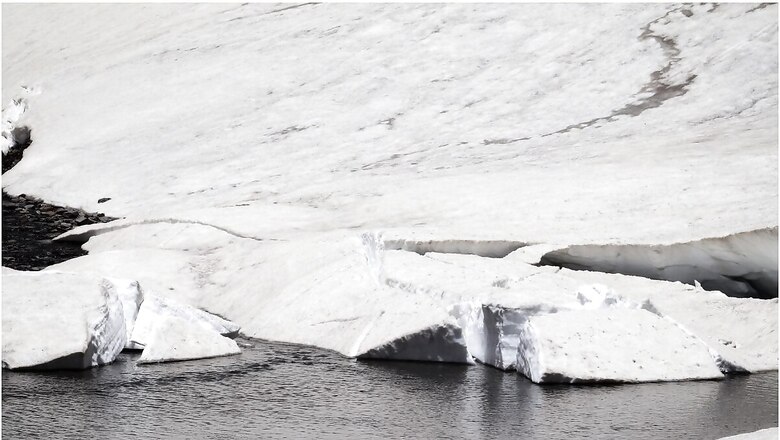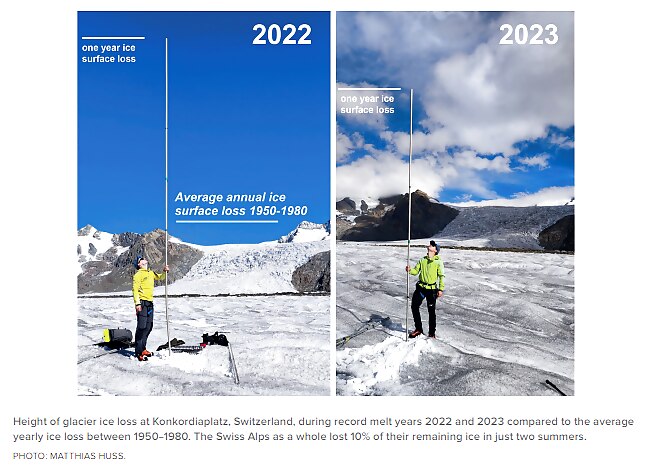
views
The Hindu Kush Himalayas can lose around 50% of today’s ice if the higher limit of the Paris Agreement–2°C warming–is reached, causing irreversible damage, warned a global group of 60 cryosphere scientists in a new report just days ahead of the 28th United Nations Climate Summit (COP28).
The report, ‘State of the Cryosphere 2023 – Two Degrees is Too High’, comes at a crucial time when nations are gearing up for key negotiations at the UNFCCC Conference of Parties (COP28) in the UAE, where the first-ever global stocktake is set to conclude. The global assessment, to be repeated every five years, will urge nations to update the Nationally Determined Contributions (NDCs) over the next two years in the wake of the climate crisis.



The latest findings reviewed by over 60 leading cryosphere scientists confirm that mountain glaciers lost ice at distressingly rapid rates over the past two summers with some disappearing entirely. The report published by the International Cryosphere Climate Initiative (ICCI) emphasised that 1.5°C is the only option to prevent further catastrophic damage. “The report is a warning to global leaders that inaction at COP28 will be disastrous,” said Dr Pema Gyamtsho, Director General, International Centre for Integrated Mountain Development (ICIMOD).
HIGH RISK OF GLOF EVENTS, SIKKIM DISASTER A WARNING
The projections show that nearly all tropical glaciers and most mid-latitude glaciers outside the Himalayas and polar regions will disappear, some as early as 2050 if 2°C warming is reached. Others are large enough to delay complete loss until the next century but have already passed a point of no return. Even the Himalayas are projected to lose around 50% of today’s ice at 2°C, the report stated. With this, the risks of landslides and glacial lake outburst floods (GLOFs) will increase. On October 3, a GLOF in South Lhonak Lake – one of the largest and the fastest-growing lakes in the Teesta basin – devastated the Himalayan state of Sikkim and destroyed a 1,200 MW hydel project downstream.
Melting even at high altitudes is becoming more frequent with even the Hindu Kush Himalaya warming at over twice the global average. The high range of mountains from Afghanistan to India that provides seasonal water to at least 2 billion people is at the epicentre of the global cryosphere with unprecedented and irreversible changes, the report warns. “2023 has been a year of climate disasters and ice loss, which has underlined the urgent need for global leaders to recognise that 2℃ is too high for Earth’s cryosphere,” said Pam Pearson, Director of ICCI.
URGENCY TO PHASE OUT FOSSIL FUELS
Scientists called upon global leaders to set clear guidelines to phase out fossil fuels, which remains a sticking point in all climate negotiations. Rich countries continue to spar over whether to include oil and gas along with coal in the final agreement. The team also urged leaders to provide definite mechanisms to finance climate action, as well as the adaptation to, and loss and damage from climate change. While COP27 last year declared the setting up of the Loss and Damage Fund, COP28 has the task of operationalising it with clear guidelines on who will be its key contributors.
“COP28, and December 2023, must be when we correct the course. Otherwise, world leaders are de facto deciding to burden humanity for centuries by displacing hundreds of millions of people from flooding coastal settlements and depriving societies of life-giving freshwater resources,” said Prof Julie Brigham-Grette from the University of Massachusetts Amherst.
LOW EMISSION PATHWAY – THE ONLY HOPE
According to the report, only the 1.5°C Paris limit and low emission pathway – that peaks at 1.8°C and returns close to 1.6°C by 2100 – could limit glacier loss to 30% in the Hindu Kush Himalaya. But time is very short and it requires at least 43% greenhouse gas reductions from 2019 levels by 2030, primarily from steep declines in fossil fuel use and net zero CO2 emissions by 2050.
While Swiss glaciers lost 10% of their remaining ice over just two years, the sea ice around Antarctica hit all-time-low summer and winter records. There is also a looming risk of extensive permafrost thaw and resulting greenhouse gas emissions which will cause temperatures to continue to rise, even once human emissions reach zero. At 2°C, annual total permafrost emissions (both CO2 and methane) would total the size of the entire European Union’s emissions from 2019, it stated.

















Comments
0 comment